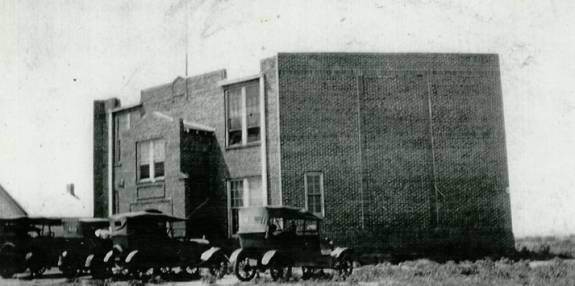(Special thanks to Ronda Myers for researching this information.)
Oklahoma Territory just prior to 1892 was divided into counties and school districts were organized by the Congressional Districts. Each school district was given 9 square miles. (Bethel actually lost some district miles in the 1890s as smaller schools such as New Hope were established nearby.) Most rural schools only provided schools through grade 8 since this was considered all the education most people needed for a basically agrarian society. According to county records, by 1893 Bethel District #25 had a school board but no teacher was listed until 1895-1896. Supposedly classes were initially held in a brush arbor. The school's nickname was "Racket" because the neighbors thought the students made too much noise! Around 1900, a wooden frame structure was either built or moved onto the NW corner of Clear Pond Road and Bethel Road. Because of the cost of keeping a school open (teacher's salaries an incredibly high $2.00 per day), many small, one-room schools sought to consolidate. By 1909 Pottawatomie had 124 schools with a County Superintendent keeping records, issuing teacher's permits, and assisting school boards. In 1910-1911 Bethel had 67 students enrolled with an average attendance of 37 and the building with its furnishing valued at $600. Their budget for the year was $400. (Note: They ended the year with a surplus of $81.14.)
In 1917 a petition to form a Union Graded District encompassing Bethel #25, West Valley View, New Hope, and Canadian Valley #113 ("Frog Pond") was submitted to the County Superintendent, H.M. Fowler, but it did not have the required 1/3 of the registered voters. It is thought that the measure failed because the consolidation would only produce a larger grade school and would not have included a high school. By February 1919, another petition was presented to the County Superintendent calling for an election to combine Bethel District #25, Canadian Valley #113, Valley Grove #23, and Oak Dale #22 into a consolidated district with a high school. The petition "explicitly stated" that the new school would be located in the "geographical center" of the four districts. All voters except those in Valley Grove approved the measure so the other schools now formed Consolidated District 3. Since Bethel was already located in the geographic center, the new school would be there and named Bethel. (The local ministers felt the nickname, "Racket" sounded too much like organized crime.) The newly formed school board consisted of N.G. McCarter, R.L. Chancellor, and J.V. Howell. Consolidated School Bethel C-3 began with 218 students in the 1920-1921 school year. NOTE: The last year before consolidation, 1919-1920, Bethel had only 63 students. It should be noted here that Valley Grove continued to have classes through the 8th grade until the early 1940s and New Hope until 1968. Declining enrollment and reduced state aide forced the closing of these smaller 8-grade schools.
The newly formed Bethel District C-3 was too large for the small, wooden frame structure and it was decided to build a brick, two-story building. (Located where the present high school now sits.) Classes were held in this building by 1921 with over 200 students.

Bethel continued to grow and when more space was needed, the decision was made to build a single story building rather than renovate the two-story brick structure. This new masonry structure was funded by the WPA (Words Progress Administration). It was to be located just south and slightly west of the two-story building. The new building was ready for occupancy in 1936-7 and the older building was dismantled in the next year. This new building housed grades 1-12 and is currently the Middle School. NOTE: Two rooms were added in 1949 to the east end of the building for kindergarten and two more rooms on the west end in later years. A wood-frame gymnasium was built (1940s) in approximately the same location as the two-story building so that Bethel could have organized sports. It also had two classrooms in the front with grades 5-6 on one side and 7-8 on the other.
In 1949 the District became an Independent School District and the school board increased from 3 to 5 members. Mr. Wilcoxson became superintendent and remained until 1968 when Glenn Coursey was hired. NOTE: In 1949 the high school produced the first WILDCAT annual. A copy is available in the superintendent's office and the Bethel High School Library Media Center.
In time there was a need for more elementary classrooms. The brick building now housing the 2nd grade was built in 1953 with only two rooms but more added in 1962. To the west a newer gymnasium, now called the "Old Gym", was built in 1955. The square brick building (1964) and the cafeteria (1966 upstairs, 1970 downstairs) were both added as needed and both were renovated in 2003.
The area where the first wood-frame gymnasium was built had been vacant and the high school had grown to the point of needing its own building so it was decided in 1973 to build a high school in stages: first an underground section which would double as a tornado shelter for the entire campus, and then an upper level built in 1977-1978. Elementary also needed more classrooms so a metal building was put in place just north of the masonry building in 1976. It now houses the 5th grade and elementary administration. A similar structure was added in the 1980s to house 3-4th grades. The B.E. Cantrell gymnasium and the north addition to the middle school, housing the Library Media Center, were added in 1986. A bond issue passed in 2003 to allow the school to build a much-needed new kindergarten/first grade building. Bethel School currently has approximately 1400 students and is once again facing over-crowding. It has an excellent reputation state-wide for its innovative teaching and dedicated staff.

 Additional settings for Safari Browser.
Additional settings for Safari Browser.


